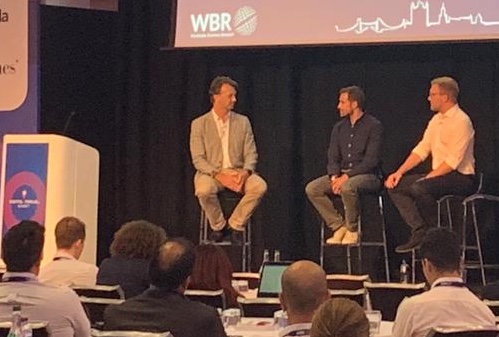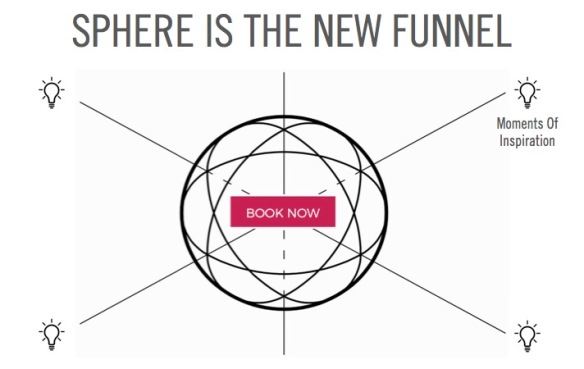Recently, in the hallowed conference halls of Twickenham Stadium – the world’s largest rugby venue – I had the privilege of moderating a panel at the Digital Travel Summit discussing what trends will transform the travel industry over the next 5 years, and how companies may capitalize on them (spoiler alert: check the title). I was joined by Finnbar Cornwall, Travel Industry Head at Google and Kamil Jagodzinski, the Chief Customer Officer of Kiwi.com. The $125M richer Kiwi.com.

Tedd, Finnbar and Kamil choppin’ it up at DTS London (IRL we’re less pixelated). Cheers Hollie Jeffries for the photo!
Nearly every conference in any industry has such sessions – so much so that they’ve become cliché. But as some wise person told me years ago “clichés get that way for a reason,” and given what seems like the ever-quickening pace of transformational technological and societal change, it’s easy to see why “future-proofing” one’s business or indeed one’s self is so popular.
Human over Machine (for now)
Rather than move down a familiar checklist of the latest technical terms du jour (blockchain, AI, voice, AR/VR, etc) we took a different approach with this panel. Technology is still a tool, a means to an end – and leading a discussion with technology tends to be a referendum on its merits. We wanted to focus on the broader trends that impact traveler behavior, whether they be the result of or a reaction to, new innovations.
Since one of the main themes of this conference was “Creating a Customer-Centric Journey,” we shared our thoughts on how each stage of the traditional travel booking process might change in the next 5 years. It was done first from a traveler’s perspective, with plenty of insights for how we as travel marketers may adapt to this changing landscape.
Now, on to the main points. Sorry, no numeric list here. It’s all about the context (and hopefully as a result for you, the Benjamins).
No Plan, No Problem
We began at the inspiration and planning phase of travel, and Kamil got us started by stating that “travel planning as we know it will disappear,” if it hasn’t already. It’s already possible for someone to show up in a destination with little forethought and no hotel for the night – a niche that Hotel Tonight cleverly carved out for itself years ago.
Finnbar added that the increasing availability of Augmented Reality will eliminate the need to read up on an attraction, when apps like Google Lens let you point your camera and read about the story of an historic building for example.
If there’s no planning phase, “will this mean the disappearance of the booking window?” I asked, since it’s a key part of timing campaigns, offers and default search dates.
Yes and no. As distribution, real-time pricing and merchandising capabilities continue to evolve, Kamil saw an opportunity to drive more last-minute group bookings – and perhaps the return of a last-minute distressed inventory model.
We’ve seen that model years ago with the likes of Priceline and Site59 (shameless shout out to my former squad). But as Kamil pointed out, “Low Cost Carriers have trained travelers to book as early as possible to get the lowest airfare.” So in that sense, booking windows will still be there if only driven by price.
So while planning the details of one’s trip may be easily put off till when you’re already there (perhaps that’s why so many trip planning startups have failed?) the actual booking – particularly for price-sensitive travelers – will likely require some forethought in order to obtain the lowest airfares.
Inspiration is Everywhere
What about the spark that starts the travel planning process? Traditionally, the inspiration phase of the booking process has received little if only skeptical, attention (apart from a few startups who’ve tried) – mainly because it was not seen as a big enough problem (doesn’t everyone have places they want to visit?) and that it didn’t make sense to invest in since it was so many steps away from the actual booking. This latter point makes a lot of sense given how much shopping around is done before making a purchase – Expedia states that some travelers visit up to 160 sites before booking!
But the sheer amount of choice confronting today’s travelers continues to grow (which is why I started TripTuner, to help travelers narrow down the options). So as a brand or destination you can’t simply sit back and expect travelers to think of you, no matter how popular you are – just see how much Las Vegas advertises, for example.

It’s time to think outside the funnel, y’all!
As booking technology advances (e.g. reserve tables natively in Instagram, or book travel via chat on Facebook) the gap between inspiration and booking has shrunk tremendously. Our panelists agreed that all you need is a few seconds on Instagram before you’re searching for flights. What this means for brands is that you now have to think more holistically about where you are targeting travelers and remove whatever friction there is to booking along that path. The traditional funnel has morphed into what I call the “Booking Sphere” – where it’s radius is the booking path and its surface are the various touchpoints – what I call “moments of inspiration” – leading to that booking. Inspiration is everywhere, and savvy marketers would be wise to think of those use cases rather than over-investing in crafting clever personas.
R.I.P. Trip Planning
Much of the inspiration happening on Instagram and other channels revolves around unique or authentic experiences. The panel largely agreed that a sea change in travel planning behavior was facilitated by the ever-expanding amount of experiential content indexed by search engines, created by bloggers, influencers and other content marketers. But trying to aggregate it or shoehorn the planning experience into an externally imposed, proprietary process can be considered a fool’s gold.
The online travel landscape is littered with the carcasses of many trip planning startups over the past 10 years (the latest of which being Utrip), yet still some seek to solve the problem that everybody purports to have…with a solution they’ll never adopt. I’ve personally felt that only Google would be able to construct a “one-stop shop” travel planning app, but even their Trips product will be sunset in August.
As more tours and activities product becomes bookable online, it will be interesting to see if a more commercially-driven “planning” product – less an itinerary builder, more of a customized, collection of bookable elements – will emerge. As I stated in the panel, however, my vote is for the scientific principle of entropy – of things tending towards disorder.
While there’s been some consolidation in online travel on a macro level, the larger trend will continue to be towards disorder and more specifically fragmentation – of the “types” of trips, booking sources, inventory providers and information sources. In such a state, with technical barriers removed by the growth of the app/API economy, the only viable one-stop shop will be those brands that are:
- used on a daily basis
- for which you already have a profile or login and most importantly,
- whom you trust with your data.
Which is why all of us on the panel felt that the main disruptive force in travel would be global players that meet those three critical criteria.
Privacy Killed the Personalization Star
Personalization is a perennial conference topic because it’s an evolving, elusive goal. For the online travel industry, it’s particularly difficult because the average person will only travel once or twice a year (for leisure at least). So you can have all the machine learning and AI you want, but for true 1-1 personalization it will take a while to build up a truly complete picture of an individual’s behavior, let alone preferences. In the absence of the frequent, nuanced conversations that a traditional travel advisor would have, it’s just damn difficult to really get a sense for traveler preferences.
Personalization is also hard because there’s a myopia within the travel industry that results from some institutional navel-gazing. We tend to divide each booking or trip into a given segment – corporate, leisure, family, romance – in a very rigid, binary fashion. We don’t look at travel more broadly as some of the disruptive players like Uber do: it’s whenever you leave your home. I mean, when is the last time you saw an ad at your gas/petrol station from a destination that’s just a full tank away?
Asia’s “SuperApps” don’t seem to suffer from that problem. They allow consumers to purchase travel along with many other goods. With daily use, they’re able to get a much fuller picture of consumer behavior. In addition, they are not bound by many privacy constraints such as those imposed by the GDPR. All of us on the panel thought that this gave them a distinct advantage over western companies when it comes to personalization, brand awareness and ability to impact the entire customer booking journey.
It remains to be seen how much privacy consumers will be willing to give up in order to have companies “know us better.” Starting with the Cambridge Analytica / Facebook debacle and other data breaches of privacy, there is a very real consumer backlash taking place. Paradoxically however, there are also studies saying how willing consumers are to give up some privacy in order to obtain some benefit.
The way forward will require transparency though, and user control. Companies can’t necessarily assume they have permission to use particular data on a customer. It needs to be obvious and permission-based.

Empathy is the path to future success. Thanks Annie Sprat for the beautiful photo.
Tell Me If You Still Care
Building empathy with consumers was a recurring theme throughout the conference, and echoed by our panelists. Connecting with today’s consumers – and those of the future – is not just a technical solution, but rather more about one’s brand and company values. Recent studies cited by Wunderman show that 89% of consumers are loyal to brands that share their values, and 56% are more loyal to brands that “get me” and show a deep understanding of their priorities and preferences.
Finnbar also mentioned how Google creates empathy by creating tools that assist today’s curious but impatient travelers. As he put it, “we’re in an age of assistance.” For Kiwi.com, it’s by showing travelers a wider range of flight options so they can more easily find the best deal. Regardless of what type of business you run, both cases provide a clear direction on how to establish empathy: through an intentional, externally focused examination of consumer behavior. As Steve Jobs said “you’ve got to start with the customer experience, and work your way back to the technology.” I can’t think of a better way to future-proof any business.
Stay tuned.

Pingback: 4 Happiness Hacks For That Post-Travel Let Down | TRAVEL x TECH
Pingback: 3 Key Marketing Paradigms for 2020 and Beyond | TRAVEL x TECH